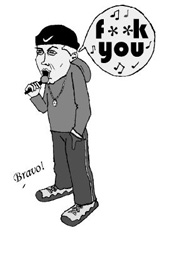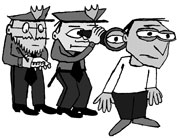The spirit of the magical nonviolent protest that infused WTO week will go back to cities and towns around the world, infusing social change movements with a new optimism and power. It was a pivotal moment in a global movement, a movement to reclaim humanity from capital.
The impact of the week of anti-WTO demonstrations, particularly the Tuesday direct action that shut down the WTO’s opening ceremonies, extended far past the inconvenience to delegates. It contributed to the WTO’s inability to agree on new and additionally devastating free trade negotiations, and shattered the WTO’s secretive aura of nonaccountability. It brought together disparate constituencies (labor, environmental, student) that have now learned to work together.
Unfortunately, when power is threatened, it bites back. That’s the most direct way to explain the inexcusable suspension of basic civil rights in Seattle for the duration of the protests. Make no mistake: the brutal police response was not triggered by the spree of property damage Tuesday. Useful as that was to apologists seeking to excuse the violence, police were already, without warning, lobbing tear gas and firing rubber pellets point blank into crowds as early as 10:05am Tuesday morning at the intersection of 6th and Union—long before any vandalism occurred.
Brutal attacks on nonviolent protesters and bystanders—having nothing to do with the property destruction that briefly occurred elsewhere—continued unabated for the next two days, for no apparent strategic reason. It was as if Seattle police—buttressed by King County sheriff officers, the state patrol, police from dozens of suburban jurisdictions, and on Wednesday by the Secret Service and National Guard—were experimenting on the downtown protesters and, by Tuesday and Wednesday nights, on Capitol Hill residents and any bystanders who happened to be minding their own business as well.
Demonstrators faced riot batons, tear gas, pepper spray, mace, concussion grenades, and three different kinds of hard plastic projectiles. The results: rubber bullet penetration wounds, broken bones, concussion injuries, and damage to the eyes and skin. Cops seized not only gas masks but also medical supplies and camera equipment from protesters in our free land. Miraculously, nobody was seriously injured or killed.
All of this against people who weren’t fighting back—who, indeed, weren’t doing anything but using what they thought were their First Amendment rights. They were, in the words of a Capitol Hill resident, “hunted down and shot like wild dogs.”
Protesters abused in jail
By Wednesday, when hundreds were arrested for doing the exact same thing they were doing legally on Tuesday, the jail and court systems also became an issue. In the face of massive protester jail solidarity, jailers responded with a panoply of reported abuses: pepper spray, beatings, isolation, restraints, stripping prisoners naked, threats of extreme violence, overcrowding, and denial of food, water, medications, and access to lawyers.
The jail mistreatment is not likely to get remedied, as it’s the protesters’ word against the denials of their jailers. But the police abuses of the week were among the best documented, by professional and amateur media alike, in history, flashed instantaneously to a horrified world. Within a week, Chief Norm Stamper and his top aide had resigned; but that’s not enough. Seattle Mayor Paul Schell invited scrutiny: “Start with me . . . if you don’t like it, don’t elect me.” Schell is far from the only culpable official, but let’s, indeed, start not with his reelection but with demands for his immediate resignation. His curfews and “state of civil emergency” were blatantly unconstitutional, allowing working and shopping but not protest. They came despite the obvious fact that there would be far fewer demonstrators on the days after Tuesday, the widely publicized rally day. Once his initial strategy failed, Schell panicked, exposing his incompetence. The range of abuses intentionally committed against nonviolent protesters suggest that Schell is not familiar enough with the First Amendment to cope with its expression, nor to be fit for public office. It belied the pretensions of Seattle to be a “world class city,” instead showing that Seattle can handle parking garages and stadiums but not democracy.
Seattle’s international reputation is now of cops in Star Wars riot gear. Get Schell out. Now. Video captured police officers under Schell’s leadership kicking a man in the groin, pepper-spraying bystanders on the ground, shooting fleeing protesters in the back, hurling tear gas canisters at people’s faces, and performing other abuses too numerous to recount. Militarized SWAT teams trained to subdue killers were unleashed on our children. These were not isolated incidents; they were part of an orchestrated political effort—an unsuccessful one—to intimidate and punish youthful protesters.
In the face of these abuses, it was remarkable that not only did anti-WTO protesters stand firm, but that they were joined by so many others who perhaps didn’t care about the WTO but cared a great deal about the Bill of Rights. The week’s rallying cry—”This is what democracy looks like”—has a double meaning. The nonviolent protests were not only what democracy should look like, but the police were how “democracy” responds when the halls of power sense dissatisfaction amongst the rabble. It showed a basic, abject fear of democracy, and that’s grounds for demanding the immediate resignations of Seattle’s highest political leaders. Stamper is not enough.
Out of 50,000 protesters, a few dozen engaged in property destruction; unfortunately, that became the international media story. It came at the expense of asking how a ragtag army of a few thousand protesters managed to shut down one of the most powerful organizations on earth—or how a police state took illegal and unconstitutional vengeance as a result.






